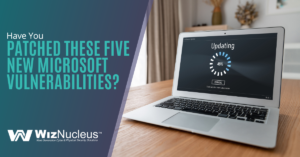A big area of cyber security and compliance includes addressing vulnerabilities before they result in a cyberattack. Vulnerabilities are flaws in software code that allow a hacker to take advantage of a weakness using malicious code that exploits the vulnerability.
For example, code in a Windows process can be accidentally written in such as way as to leave a “loophole.” This loophole creates an opportunity for code to be written that allows a hacker to give a system command that is not intended, such as one to control the device remotely.
Vulnerability scanning is done as part of good cybersecurity practices to identify any potential vulnerabilities lurking in the technology infrastructure of an organization or mission-critical facility. Once these are detected, steps can be taken to eliminate or mitigate the risk they pose.
One way this is done is by identifying a security patch for a found vulnerability and applying that patch. Another may be to restrict the capabilities of the vulnerable application, so a hacker’s exploit won’t work.
But none of that remediation can happen until the vulnerability assessment is performed to detect any existing system vulnerabilities. Without that, organizations are in the dark and bound to get caught off-guard with a hacker finding their vulnerabilities before they do.
What Happens During a Vulnerability Scan?
Tools like Cyberwiz-Pro from WizNucleus are used to automate the vulnerability detection process. They dramatically reduce the time it takes to seek out potential system weaknesses so these can be addressed before they’re exploited to cause a breach.
These tools use a systematic approach to identify all the assets in a system. Then these are scanning for any issues that may make the network vulnerable to a cyberattack.
It’s estimated that approximately 93% of corporate networks can be penetrated by a hacker.
Here are things that are detected during a vulnerability scan:
- Devices (critical and boundary)
- Application security testing loopholes
- Outdated web applications
- Vulnerability gaps
- OS vulnerabilities
- Software vulnerabilities
- Hardware vulnerabilities
- Open-source web-based vulnerabilities
Example of vulnerability reporting from Cyberwiz-Pro
Once the scan is complete, a comprehensive report is generated that includes details on what was detected. There may also be recommendations included for remediating the threats to your mission-critical facility or company.
Six Steps of Vulnerability Detection
Define the Scope of the Testing
Before you begin a vulnerability assessment, you should first define the scope of the testing. Are you including specific areas of your network only, or including your entire IT infrastructure? Will you be including remote worker devices and networks as well?
First define your scope, as it’s important to document any areas not included that may still pose a potential risk.
Perform Vulnerability Assessment
Next, is to have the vulnerability assessment scan performed. If done manually, this can take a lot of time and IT resources. A better way is to use an automated vulnerability assessment tool that will conduct the scan quickly and thoroughly.
Prioritize Vulnerabilities
Once the vulnerabilities are identified, prioritization needs to happen. If you’ve used an automated tool, then this is usually done for you according to the Common Vulnerability Scoring System (CVSS).
Prioritization is necessary to ensure you’re addressing the most critical and dangerous vulnerabilities first and classifying less critical vulnerabilities at a lower priority.
Remediation
The next step is to address the found vulnerabilities in the order of priority. This is the entire purpose of vulnerability detection, to reduce risk by finding and mitigating potential threats to your network cyber security and compliance.
The type of remediation used will depend on the vulnerability and whether it is “zero-day,” meaning a patch may not yet have been issued for it.
Remediation can include:
- Applying a patch
- Restricting applications through ringfencing
- Using a safelist to only allow certain applications to run
- Increasing advanced threat protection settings
- Removing any outdated and no longer supported web or software applications
Verify Remediation
Once your remediation has been put in place, you should verify this by doing another scan of your system. You should see your risk score reduce upon this second scan. This ensures that nothing was forgotten or missed and that found vulnerabilities were addressed appropriately.
Document Activities
Documentation of vulnerability assessment and management activities should be performed and reported on. This provides an important log to reference should you suffer an attack in the future. It also is a necessary document for data privacy compliance, and should you suffer a breach, having documentation of your efforts to secure your network can lead to a reduced penalty.
Use a Smart Vulnerability Assessment Tool
WizNucleus can assist your mission-critical facility or organization with smart solutions for automated vulnerability assessment and remediation.
Contact us today to schedule a free consultation! Call +1 (646) 558-5577 (New York, NY) or +1 (469) 481-1726 (Carrollton, TX) or reach out online.





